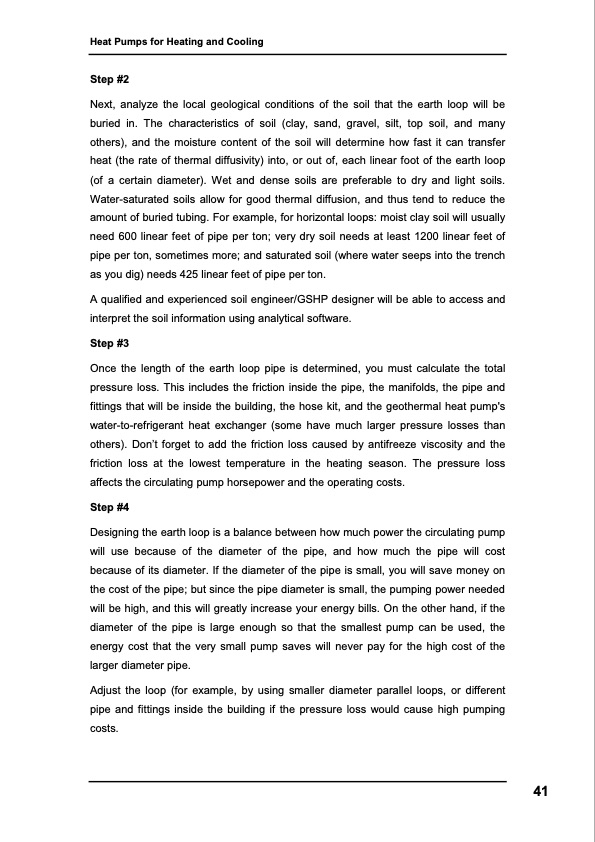
PDF Publication Title:
Text from PDF Page: 042
Heat Pumps for Heating and Cooling Step #2 Next, analyze the local geological conditions of the soil that the earth loop will be buried in. The characteristics of soil (clay, sand, gravel, silt, top soil, and many others), and the moisture content of the soil will determine how fast it can transfer heat (the rate of thermal diffusivity) into, or out of, each linear foot of the earth loop (of a certain diameter). Wet and dense soils are preferable to dry and light soils. Water-saturated soils allow for good thermal diffusion, and thus tend to reduce the amount of buried tubing. For example, for horizontal loops: moist clay soil will usually need 600 linear feet of pipe per ton; very dry soil needs at least 1200 linear feet of pipe per ton, sometimes more; and saturated soil (where water seeps into the trench as you dig) needs 425 linear feet of pipe per ton. A qualified and experienced soil engineer/GSHP designer will be able to access and interpret the soil information using analytical software. Step #3 Once the length of the earth loop pipe is determined, you must calculate the total pressure loss. This includes the friction inside the pipe, the manifolds, the pipe and fittings that will be inside the building, the hose kit, and the geothermal heat pump's water-to-refrigerant heat exchanger (some have much larger pressure losses than others). Don’t forget to add the friction loss caused by antifreeze viscosity and the friction loss at the lowest temperature in the heating season. The pressure loss affects the circulating pump horsepower and the operating costs. Step #4 Designing the earth loop is a balance between how much power the circulating pump will use because of the diameter of the pipe, and how much the pipe will cost because of its diameter. If the diameter of the pipe is small, you will save money on the cost of the pipe; but since the pipe diameter is small, the pumping power needed will be high, and this will greatly increase your energy bills. On the other hand, if the diameter of the pipe is large enough so that the smallest pump can be used, the energy cost that the very small pump saves will never pay for the high cost of the larger diameter pipe. Adjust the loop (for example, by using smaller diameter parallel loops, or different pipe and fittings inside the building if the pressure loss would cause high pumping costs. 41PDF Image | Heat Pumps for Heating and Cooling

PDF Search Title:
Heat Pumps for Heating and CoolingOriginal File Name Searched:
heat-pumps-for-cooling-r1.pdfDIY PDF Search: Google It | Yahoo | Bing
CO2 Organic Rankine Cycle Experimenter Platform The supercritical CO2 phase change system is both a heat pump and organic rankine cycle which can be used for those purposes and as a supercritical extractor for advanced subcritical and supercritical extraction technology. Uses include producing nanoparticles, precious metal CO2 extraction, lithium battery recycling, and other applications... More Info
Heat Pumps CO2 ORC Heat Pump System Platform More Info
| CONTACT TEL: 608-238-6001 Email: greg@infinityturbine.com | RSS | AMP |